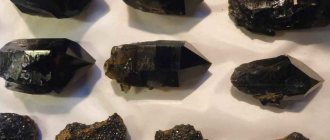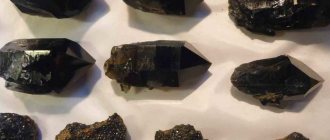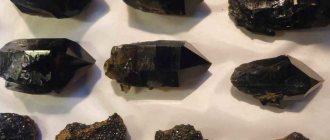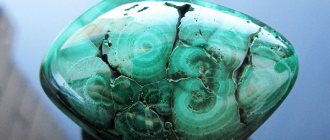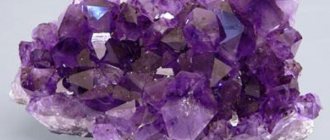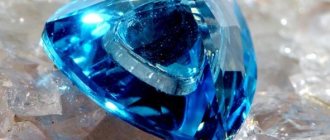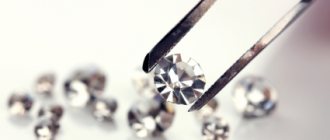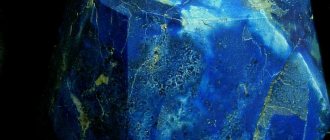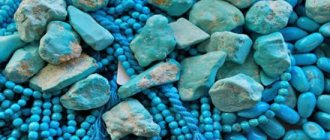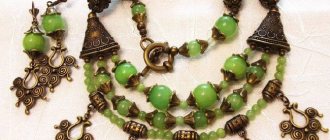To figure out how to distinguish an emerald from a fake, you need to clearly understand its appearance and become familiar with the properties of stones that are similar to it. After all, there are a number of green minerals that can easily be confused with true jewelry. However, natural emerald, as this crystal was called in ancient times, is not always more expensive than a high-quality imitation. The evaluation takes into account clarity, cut, size and other qualities.
External features
First, let's tell you what emeralds look like. Ideal stones are transparent green crystals in which the color is distributed evenly over the surface. But such species are rare.
Nature has been working on the creation of minerals for millions of years. This happens in different conditions, where other rocks “live” nearby. Their particles get inside and create pinpoint inclusions that affect the color, giving yellowish or bluish tints.
Transparency is impaired by the presence of gas or liquid particles. Once built into the structure of the emerald, they make it cloudy. Cracks that occur as a result of temperature and pressure changes affect the quality of the stone. Based on the listed characteristics, it is easy to recognize a natural mineral. The cost of matte emeralds depends on the degree of “fog”. The more it is, the cheaper it is.
Beryl or emerald: which mineral will bring health
In this matter, the situation is the same as with the magic of minerals. Emerald will certainly give you all the healing capabilities of beryl and at the same time add some special healing properties.
Beryl itself is an excellent guardian of human health. It stimulates the body's immune forces, making it more resistant to various diseases. In addition, this stone has a particularly beneficial effect on the gastrointestinal tract, improving metabolic processes and freeing the body from toxins.
In lithotherapy, a medical practice in which doctors use only natural stones for treatment, beryl is used to heal all kinds of colds and back pain.
Emerald, in addition to the healing properties of beryl, has additional abilities.
- So, it has an excellent effect on the cardiovascular system and helps normalize blood pressure.
- Lithotherapists use the stone to combat, first of all, unhealthy mental conditions. It is believed that the mineral helps get rid of the feeling of chronic fatigue, depression, unreasonable fears, insomnia, etc.
- But the gem is also used to save from diseases of the stomach, kidneys and bladder.
- By the way, emerald is also famous for its antibacterial properties. If you put it in water for a while, you can safely drink it without boiling or filtering.
No different from beryl
But even an opaque emerald remains a precious stone, which belongs to the first-order gems of the beryl group. The chemical composition of the green mineral is no different from beryl. At the end of the 18th century, this was proven by the scientist Louis Vauquelin.
For 50 years, emerald was classified as a separate type of stone. But in fact it is beryl, which acquired a green color due to the admixture of chromium or vanadium oxides. Untreated minerals are often unevenly colored. Read about how natural qualities are improved in the article “Processing and cutting of emeralds”
Now let's move on to how to determine the authenticity of an emerald. The necessary parameters for evaluation are color, clarity and weight. This was also discussed in the article “How can you distinguish a real emerald from an artificial one.” Here the choice depends on the taste and desire of the buyer.
What is beryl
This mineral is a component of beryllium ores and belongs to the subclass of ring silicates. More often it appears as prismatic crystals. They are single, connected into druses, columnar agates.
There are many color options for beryl. This diversity is provided by various impurities. The stone has a glassy luster.
The chemical composition of beryl is represented by the following elements:
- silicon dioxide (almost 70% of the composition);
- aluminium oxide;
- beryllium oxide.
The gem is used in jewelry and small crafts are made. Opaque stone is an ore mineral. With its help, beryllium oxide is obtained.
Origin story
As with emerald, the name beryllium comes from a series of borrowings from different languages. Translated, it means a sea-green colored gemstone.
The source of the mineral is pegmatite veins formed by the crystallization of acidic magmas. Metamorphic rocks also contain it.
How to mine
Beryl deposits are often complex. It is mined together with rock crystal, smoky quartz, topaz, morion, and feldspar.
There are many deposits of the mineral. They differ in the types of stone extracted and the depth of its occurrence. There are several largest deposits:
- Madagascar - this is where the largest beryl was found, 18 m long, 3.5 m in diameter and weighing 380 tons;
- South America (Brazil, Colombia);
- Russia (Ural).
Mineral deposits are found using the geophysical method - berylometry.
Varieties
Pure mineral is colorless. The division of the mineral into types is due to differences in color. The shine of the stone is always glassy.
One of the most beautiful varieties of gems is augustite. It was found only in Brazil at the Maxis deposit, which is why it is also called Maxis beryl. The color of the stone is dark blue.
One of the most famous varieties of beryl is aquamarine. It can be blue or greenish-blue in color, reminiscent of sea water. It was the coloring that gave the gem its name.
About a century ago, bazzite was discovered. This variety of beryl can be pale or intense blue, blue-green, or deep blue.
In jewelry there is a type of stone called noble. It has an interesting apple green coloration. There are also noble ordinary gems. It is transparent and pale in color.
A rare type of mineral is bixbite. It is called red beryl or red emerald. It was discovered at the beginning of the last century. The sizes of gems of this type are not large - up to 10 carats after cutting. Bixbit is popular mainly among collectors.
Another rare type of mineral is sparrowite, also called morganite or pink beryl. Due to the manganese content, it can be pink, violet-pink, reddish, amber.
One of the transparent varieties of the mineral is heliodor. It is also known as Davidsonite. Its color can be yellow, orange or golden yellow.
Another transparent type of gem is goshenite, also called white beryl. It has no color.
Other green stones
We will explain below how to distinguish a real emerald when purchasing in a store. Let's start with color, because this is the main advantage that natural stone has. However, nature has a long list of green minerals. Without understanding the intricacies of jewelry, it is easy to make a mistake and mistake it for a jewel, for example, an ornamental material.
Emerald-like stones:
- nephritis;
- alexandrite;
- tourmaline;
- jade;
- chrysolite;
- chrysoprase.
This is not a complete list of minerals that have an emerald color. In the article “Emerald in comparison with other stones”, get acquainted with detailed characteristics.
With certain processing in jewelry, any of them can become an imitation of precious emerald. However, each is very different from a true gem.
Emerald and beryl products
You can find jewelry made from various types of beryl in any jewelry store. The most expensive options are emerald, morganite and bixbite.
The frame for them is usually 750 gold and platinum. Products with bixbit are made to order.
Jewelry made from aquamarine, goshenite, and heliodor are more accessible. Goshenites are usually combined with silver, while heliodors look better in gold. For aquamarines, the frame is made of white gold or silver.
Beryl jewelry is worn not only by women, but also by men. The frames of products for the stronger sex are often represented by silver, white gold, and platinum. The men's assortment consists mainly of cufflinks, signet rings, bracelets, and pendants.
Product prices
The cost of beryl products depends on the type of stone, its size, setting, and cut. A silver ring with aquamarine can cost about 3,500 rubles, a gold ring with heliodor - 11,000 rubles, and with bixbite - 15,000 rubles. Jewelry made to order reaches the maximum value.
One of the most expensive jewelry in the world is a tiara with emeralds and diamonds. Its cost is almost 13 million dollars.
Look through the magnifying glass and listen to the heart
Remember the rules that will help you distinguish a fake. There is not much difference between a pawnshop and a store, so you can shop anywhere. But it's good if it's a reliable seller.
Here are three tips on how to check an emerald. First, dark-colored emeralds are more expensive, but in poor lighting they “play” poorly and look dull.
Second, do not judge the purity of a piece of jewelry too harshly. Foreign inclusions added by nature, as well as “veils” of gas or liquid, make it truly “alive.” The definition of transparency of natural stone is relative. “Pure” minerals are rare. Crystals with turbidity often look original. Therefore, base your choice on your feelings. If your soul and heart are inclined to buy, then this is your copy.
Third, the larger the emerald, the more expensive the cost of each carat that makes up its weight. A massive, but cheap, mineral should raise doubts about its authenticity.
However, we do not recommend relying on the price indicated on the label. A high-quality fake, for example, from a Ural demantoid, can cost more than a genuine average-quality emerald . Skilled jewelers also make gluing stones from several small stones.
Jewelry with beryl for treatment
Lithotherapists insist that not only the color of beryl is important, but also how and in what type of jewelry a person wears it.
- Earrings decorated with stones will help with headaches and toothaches.
- A bracelet or ring will help create a healthy reproductive system.
- The pendant will protect even from advanced respiratory diseases, including helping to quit smoking.
- Beryl keychains will improve men's health.
Lithotherapists (doctors who use natural stones for healing) use minerals as a cure for back pain and colds. The treatment method is as follows: a stone is placed on the diseased organ and a beam of light is directed at it.
Layered fakes
To check an emerald in a store or at home, you will need a magnifying glass with twenty times magnification. If you see two or three different layers, then they are trying to sell you a doublet or triplet. These are special types of counterfeit goods, when a cheap imitation is taken as a green base. A plate of real emerald is glued on top. Counterfeits set in gold look like real jewelry. But no matter how beautiful they are, they remain imitations. Hence the conclusion: it is better to determine the authenticity of an emerald if it is not set in a frame.
This type of counterfeiting dates back to ancient times. When such “jewelry” became widespread, pawn shops stopped accepting jewelry as pawn. Precious stones were always taken out of rings and pendants. Venetian jewelers were the first to come up with the gluing method. Since then it has been improved many times.
These days, triplets and doublets are often made from real emeralds, but the stones are of poor quality. However, they are selected so as to create an attractive external effect. Take transparent, but not too bright emeralds. Saw horizontally. Polyester resin is applied at the cut site. It is colored with pigments. Then everything is glued together. This procedure gives the effect of the presence of foreign inclusions and minor defects.
It is impossible to identify such high-quality fake emeralds on your own. This can only be done using spectral analysis.
How to distinguish natural stones from fakes (video)
There is an opinion that beryl is an excellent talisman. Whatever the stones are: green, yellow, blue or cyan, they are able to equally strongly protect a person from negativity. Anyone can afford such an amulet. Beryl gems can attract good luck and the attention of the opposite sex. In addition, they contribute to the successful resolution of litigation and getting rid of vain thoughts.
Thus, beryl is a truly wonderful gem. By choosing jewelry or talismans with such a mineral, you can not only get an addition to your image, but also protect yourself from negativity, receiving a lot of positive emotions.
Beware of fancy names
Imitations of emerald from green glass began to be made back in the Middle Ages. Syrian glassmakers came up with a method where the glass turned out to be very similar to a precious stone. Later the secret became known to Europe and the whole world. Now there are also specialists who make special glass from beryl and tint it with chrome. But whatever the result, a specialist will always distinguish a genuine jewel.
Another method of disguising itself as a precious mineral is common among scammers. For example, there are Brighton emerald or emerald. Don’t be tempted by the beautiful names: although this is unusual, it’s just green glass.
Above we told you how to distinguish a natural emerald. We hope that our tips will help you recognize a glass fake. Using a magnifying glass, you can easily notice a triplet or doublet, where the top layer is emerald and the base is bright green glass.
Place of Birth
Deposits of gems are found all over the planet. A lot is mined in Europe (Germany, Sweden, Austria). In Russia it is mined in the Sverdlovsk region.
The best and most expensive emeralds are mined in Colombia. They contain an admixture of calcite and fluorite, which helps to accurately determine the country of origin of the gemstone.
50-90% of all green gemstones are mined in Colombia.
There are also deposits:
- In Zambia. Precious stones from this region have a beautiful dark color and can compete with minerals from Colombia, since they are practically free of defects.
- In Brazil. The minerals obtained in this country are light in color and have a high degree of purity. It was here that the largest emerald was mined, weighing 11.5 kg. In conversion, this is 57.5 thousand carats.
- In Russia in the Urals. Here emerald places were discovered back in the 19th century. Unique specimens of not only emeralds, but also alexandrite and phenacite are mined here.
- In Afghanistan. Gems from this country are not inferior in cost to Colombian stones. The crystals are denser and very hard, which allows for excellent cutting.
- In Egypt. Stone quarrying has been practiced here since the 17th century. At that time it was believed that the green gem was afraid of light, so it was mined in the dark.
To find mineral deposits, berylometry is practiced - one of the methods of nuclear reconnaissance geophysics.
Rechargeable Tourmaline
In nature, tourmaline is green in color, which makes it look like an emerald. They try to sell cheap imitations at a higher price. Tanzanian minerals that contain chromium are often used.
If the stones are not set into a piece of jewelry, they are easy to recognize. Tourmaline crystals are very different in shape from emerald. They look like elongated prisms, sometimes of different colors in one stone. The colored stripes alternate, and the longitudinal shading is clearly visible. It runs in strict parallel lines relative to the main axis.
Green tourmaline has no luminescence. Another of its features is the ability to become electrified by friction and heating. This is the correct way to check. If you rub a pebble, everything will become clear. And if you have the opportunity to use a refractometer, you can measure the degree of refraction of light. This figure should be approximately 1.64. A real emerald has less.
How to care for beryl
These stones should be handled with care as they have a very fragile structure. If you drop a piece, it will break. It is recommended to wash the stones under running water.
Emeralds require slightly different care. This stone is quite soft. In contact with other minerals, it may lose its luster due to damage to the edges. In this case, it is necessary to sand the top layer.
Parallels and optical effects
The color palette of artificial cubic zirconia may also contain all sorts of shades of green. Through a magnifying glass, ordered parallel lines of the artificially grown crystal will be visible. A real emerald has the same parallels arranged chaotically.
It is very difficult to spot a fake among small-sized gems. This is especially true for chrysoprase. The crystal is saturated with nickel. If the pebbles in the chrysolite placer weigh no more than 0.5 carats, then a specialist with instruments will be required.
In larger specimens, some differences can be seen through a magnifying glass. If, in addition to bubbles and dots, you notice inclusions in the crystal in the form of “feathers,” then it is chrysoprase and not emerald. There is also a difference in color. The latter is brighter. In addition, they have different iridescence, that is, a rainbow glow effect that appears after processing.
If you look at a cabochon-cut emerald in good lighting, you will rarely see a star with six rays. Typically, the optical effect of an asterism shows a “fading” star with wide cone rays. These signs will explain why chrysoprase is cheaper.
Physical and chemical properties of stones
The first beryl jewelry appeared on the planet more than 6 thousand years ago. These minerals are valuable not only for the jewelry industry, they are valuable raw materials for electronics and nuclear technology. Also used in the production of X-ray machines.
Emerald
Bright, rich green color with different shades is the main distinguishing feature of emerald. Moreover, the darker and more saturated the tone, the more expensive the gemstone. Each deposit is famous for emeralds of a different shade. It can be either almost light green or the color of lush grass. Such shades are given to it by vanadium and chromium in the composition of the mineral, and you don’t need a lot of these metals: only 0.5% of compounds turn beryl into a gemstone of the highest order. In terms of cost, it often rivals even diamonds.
Emerald can be:
- strong blue-green;
- blue-green;
- weak blue-green;
- green.
There is even a separate cutting method for emerald, since the stone is more fragile than other beryls. It is also often given a cabochon shape. All the smallest pores and cracks are filled with oils - natural or synthetic. This is how the stone is refined. For natural stones, colorless oil or with the addition of pigment is used to enhance the natural color of the mineral. Processing is carried out under vacuum conditions. The hardness of a green gem according to the Mohs table is 7-8 units. The stone is believed to have the ability to cure many diseases.
Beryl
Beryls are included in the subclass of silicates. In addition to beryllium compounds, they also contain silicon oxides and aluminum oxide. The color is determined by additional impurities. These hard minerals are only slightly inferior to diamond, with a hardness of 7.5-8 on the Mohs hardness scale. The mineral is resistant to acids. It has a glassy luster, is prone to uneven fracture, and is quite fragile. There are both translucent and transparent representatives.
The presence of iron compounds gives yellowish, turquoise, blue color. If the stone contains lithium and manganese at the same time, then the rarest color range will be obtained - a red gem. If morganite (vorobievite) is heated, its shade will become even more saturated.
Origin of the mineral
Beryl (beryllium aluminosilicate) is of igneous origin (in rare-metal granites and pegmatites) and post-magmatic (in quartz veins, greisen and cavities in rhyolite).
Additional Information. Under a combination of favorable conditions, the crystals can grow very large, thinning towards one or both ends.
It originates in the voids of rocks, since it needs free space for development, and crystallizes into hexagons.
The beryl stone has been known since the 6th century BC, where it was used in the ancient technique of jewelry processing of precious minerals, which resulted in elegant gems. The name “beryl” most likely comes from the Greek transcription “beryllos”, which means shiny stone. English name – Beryl (beril).
Additional Information. In honor of this stone, in 1936 an Italian submarine was named Berillo.
Places of extraction and use
Deposits of the mineral beryl are numerous: Russia (Altai, Transbaikalia), Ukraine, Brazil, Canada, USA, Afghanistan, India, China, countries of South Africa. Emeralds are mined in Russia (Ural), Austria, Pakistan, Brazil and Colombia.
In jewelry production, transparent and translucent colored stones are used, which make up several kilograms of the 10 thousand tons of mined minerals. The remaining technical matte beryl is used for beryllium production.
Additional Information. Beryllium is better than aluminum due to its heat capacity, heat resistance and thermal conductivity.
Beryllium stone is widely used in metallurgy, nuclear industry, laser technology, aerospace engineering and nuclear power.
The difference between imitation and natural mineral
Additional Information. Only emerald is grown artificially for jewelry purposes; other stones are not economically viable to synthesize.
Artificial beryl and its varieties are obtained through synthesis of fairly high jewelry quality. It is possible to distinguish such a stone from natural varieties of beryl only in a specialized laboratory.
Glass, cheaper and synthetic stones are used as beryl counterfeits: beryl, garnet, corundum, cubic zirconia, spinel.
You can distinguish fakes first of all by their hardness (beryl is harder than glass), color and optical properties (for a fake it is too uniform); natural stone has dashes, chips, and inclusions.
Magical properties of emerald
Ring with an emerald
The symbolism of emerald and the meaning of the emerald stone are revealed to modern people by ancient written sources. From the 4th century came the words of the church leader Epiphanius, who wrote that the magical properties of the emerald stone help to foresee the future.
Armenian manuscripts of the 10th century contain beliefs that this gem is able to repel snakes and is a reliable antidote.
In Czech ancient descriptions there is a sign that it fades when it falls into the hands of dishonest people. No wonder medieval magicians called it the “stone of truth.”
The famous Italian astrologer of the 16th century, Cardano Gerolamo, attributed to the mineral the ability to sharpen intuition and intelligence.
Thus, the magical properties of emerald develop subtle sensitivity, inspiration for great deeds, allow you to see the aura of others and endow its owner with the ability to control the will of others. Apparently, this is why many rulers held in their hands staves, orbs, and scepters topped with emerald inserts.
The green mineral is also credited with the ability to attract good luck and the ability to direct a person’s sexual energy, and these are the highest levels of love magic. Court sorcerers once used it as an attribute of divination, when the fate of entire states depended on love intrigues.
But not only human emotions can be pacified or inflamed by a gem. The elements of nature, for example, a storm, are also subject to it. Therefore, sailors and fishermen have long considered it their stone.
It is believed that it is better to receive a ring with an insert made of this gem as an inheritance gift: the stone absorbs the wisdom of previous generations. The most famous such gift is the ring of A.S. Pushkin, which the poet gave to his friend Vladimir Dahl before his death.
Pushkin considered this ring with an emerald to be his talisman and dedicated the poem “Keep Me, My Talisman” to it.
Dahl really appreciated this gift and said that for him it also became a real talisman and inspired him: “As soon as I look at it, a spark runs through me from head to toe, and I want to get down to something decent.” Now this ring can be seen in the apartment-museum of A.S. Pushkin.
But there are supporters of another theory associated with antique emeralds: outliving its owners, the gem absorbs the magic of death and becomes the successor of destructive energy, a spear aimed at the owner.
That’s why they sometimes say: emerald is the stone of death. This meaning is also attributed to stolen emerald jewelry: this is how the stone of truth punishes cruelly for a sin committed.
How to wear it correctly
It is necessary to wear emerald jewelry correctly, taking into account the properties of the stone:
- It is advisable to have a full set of jewelry - it is stylish. In such a situation, the stones have the opportunity to better influence the owner.
- If you want to have a stone in the form of a talisman, it is better to keep it untreated.
- Be sure to consider whether the mineral is suitable for your zodiac sign. Scorpios and Capricorns should not purchase such an amulet.
- Wear jewelry on the little finger, but since this nugget is a love amulet, it is allowed to be worn on the ring finger.
Practical recommendations
Beryls are generally fragile stones and must be handled with care.
Rules for care and wearing
Important! The stones are very fragile. It should not be exposed to sunlight, as the color becomes lighter and lost when exposed to sunlight, and can only be restored under laboratory conditions.
Since beryl is resistant to alkalis and acids, if it becomes dirty, it can be cleaned with chemicals: a solution of baking soda or ammonia. Must be protected from force.
There are several ways to clear stones of accumulated negative energy:
- Hold the stones briefly under cool running water. Better in a clean stream or river. But if there are no other options, then tap water will do. After cleaning with water, do not wipe the stones, but leave them to dry on their own, placing a lit candle nearby.
- Leave the stone overnight on the windowsill under the light of the waning moon, preferably three days before the new moon.
- Place the stone in a glass container, place it in a large container with sea salt and leave overnight.
Cost of beryls
The price of minerals depends on the variety. Each variety has its own price range depending on the shade and color saturation, size, clarity and cut of the stone.
- Emerald is the most expensive of the beryl group and belongs to the first order precious stones. Stones of the highest category are extremely rare and cost depending on size: from 0.01 to 0.09 carats $700-1000 per carat;
- from 0.10 to 0.49 carats $1100-2000 per carat;
- from 0.50 to 0.99 carats $2000-3500 per carat.
- from 0.01 to 0.09 carats $90-600 per carat;
- from 0.01 to 1.99 carats $10-120 per carat;
- High-grade stones reach $1,500 per carat,
- top quality sells from $350 per carat,
- the highest quality has the deepest color and costs $150-300 per carat,
- highest quality – $200-650 per carat;
